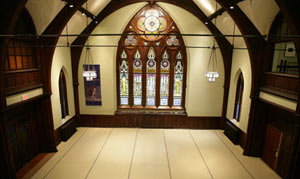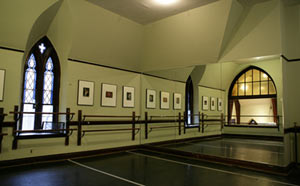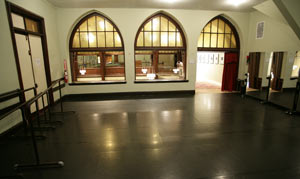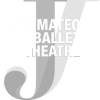
José Mateo Ballet Theatre’s home, Old Cambridge Baptist Church, is a focal point in the Harvard Square Historic District. The facility has been registered on the National Register of Historic Places since 1982, on the Massachusetts Register of Historic Places and is a contribution feature of the mid-Cambridge Neighborhood Conservation District.
The facility is an outstanding example of the American Gothic Revival style of architecture. Designed by noted Boston architect Alexander R. Esty and erected between 1867 and 1870, the facility boasts soaring 50-foot ceilings, an important collection of 19th and 20th century stained glass, expansive interior spaces and the tallest cut-stone spire in Middlesex County.
Built of local fieldstone and granite quarried in Somerville, Massachusetts, the building is a notable example of the muscular use of stone, typical of American Gothic Revival architecture. This solidity, coupled with Esty’s display of structural strength in the asymmetrical massing of forms, is further accentuated by the contrast between heavy gray stone and large, graceful, delicate stained glass windows, which the stone walls simultaneously reveal and protect.
In 1897, the original Parrish Hall was lost in a fire. The rebuild was complete under the direction of noted Boston Theater Architect, Clarence Blackall. The most notable feature of the reconstruction is an 1890 Tiffany & Company window. This early Tiffany window bridges the gothic stained glass tradition and emerging art nouveau movement.
In July 2000, the congregation of Old Cambridge Baptist Church and José Mateo Ballet Theatre embarked on a partnership designed to provide the ballet with space for teaching, rehearsing and performing and to pool the financial and human resources of both organizations to advance the ongoing restoration and conservation of this facility.
Six and a half days a week, José Mateo Ballet Theatre’s dancers, teachers, musicians and students (ages 3–80) fill Studio 1 (The Sanctuary and The Sanctuary Theatre) Studio 2 (The Parrish Hall), Studio 3 (The Little Sister Studio) and Studio 4 with music and movement. On Sunday mornings, these same spaces resonate with the praises, prayers, and preaching of the congregation. Our shared use of spaces, for both dance and worship, is symbolic of the complementarity between the loftiest aspirations of dance and the earthiest intent of worship. Today, Old Cambridge Baptist Church is a vibrant place where art finds sanctuary and worship finds studios for the practice of the arts of spiritual life.
Currently, the National Trust of Historic Preservation is developing a case study citing the development of José Mateo Ballet Theatre’s home as one of the best examples of the adaptive reuse of a house of worship in the United States. Since its inception the project has benefited from the vision, expertise, and dedication of Brad Bellows, a Cambridge Architect.
It’s striking how well you come to know the dancers during the performance. Separated only by a bit of floor space, the audience is wrapped into the experience as if invited into the home of friends.
Iris Fanger, Patriot Ledger
THE STUDIOS

STUDIO 1 – THE SANCTUARY THEATRE
Built in an original 1867 sanctuary, Studio 1 is awash in colored light from its 25 stained glass windows. At 90’ x 50’, with 50-foot ceilings and 18-foot tall mirrors, Studio 1 is among the most expansive dance spaces in the country. A custom-made, injury-reducing sprung floor, designed and installed by noted dance floor experts Wooden Kiwi, and a 6’4” grand piano make working in Studio 1 a truly sublime experience.
The Sanctuary Theatre is designed to present ballet close-up! In the cabaret format, 100 guests are treated to José Mateo’s original choreography in a casual and intimate setting. Audience members are seated around cocktail tables, can visit the bar at every intermission for beer and wine, and enjoy live piano music before the show and at intermissions.
… The Sanctuary Theatre inside the Old Cambridge Baptist Church provides an almost religious experience. The seats are so close that you can see every slash of muscle, hear each clack of a pointe shoe, and practically feel the performers’ exhalations. The intimacy lends Mateo’s dynamic choreography a raw power that’s compulsively watchable, whether you’re a ballroom expert or have two left feet.
Best of Boston 2011, Boston Magazine

STUDIO 2
Studio 2 boasts one of the oldest Tiffany windows in the country (1890), which was completely restored in 2007. The studio retains the original raised panel wainscoting and dental moldings, and measures 40’ x 40’. Its 40-foot ceilings and 12-foot high wall of mirrors make Studio 2 an inspirational dance space. Equipped with a portable sprung flooring system and a newly restored 1928 Mason Hamlin 6’2” grand piano, Studio 2 is a state-of-the-art dance space built within one of the most beautiful rooms in Cambridge, Massachusetts.

THE LITTLE SISTER STUDIO (STUDIO 3)
Given in loving memory of Amanda and Patricia Picardo, a young dancer and a parent volunteer. Nestled in the eaves of the building, and overlooking Studio 2, The Little Sister Studio, at 20’ x 25’, is the perfect size for early beginner classes. Used extensively for Creative Movement and Pre Ballet, The Little Sister Studio is an intimate space with cozy window seats. State-of-the-art, injury preventing dance floors create the safest environment for our youngest dancers. Equipped with mirrors and an upright piano, The Little Sister Studio is an ideal space to begin a lifelong love of the art form.

STUDIO 4
Measuring 25’ x 25’, Studio 4 is ideally suited for children’s ballet classes. Equipped with an Allegro Harlequin dance floor, a new Yamaha upright piano, and stained glass windows on three walls, Studio 4 is a unique environment for young artists to begin their formal study of dance.
RENTAL RATES
ADDITIONAL INFORMATION
Cancellation Policy: 72 hours prior to event
Payment due at time of booking
Any renters serving alcohol must obtain a valid liquor license from the City of Cambridge and carry a liquor liability insurance policy
Renter is held responsible for any damage to the building and equipment
No tolerance policy for smoking, drugs and non-permitted alcohol
Rental priority is given to movement-based arts
Questions? Email us at info@ballettheatre.org.























































